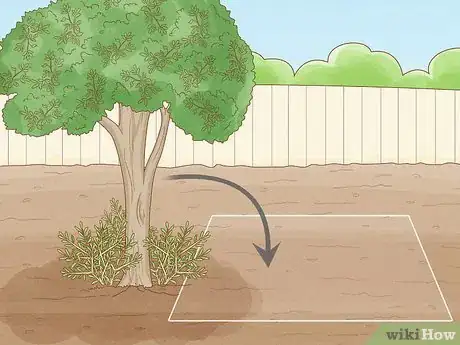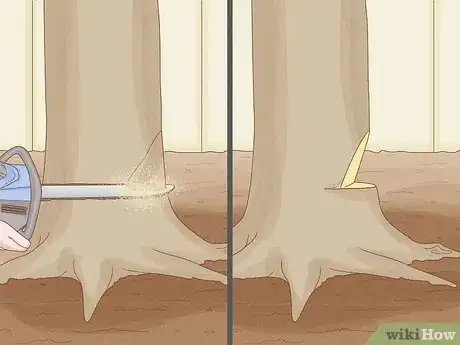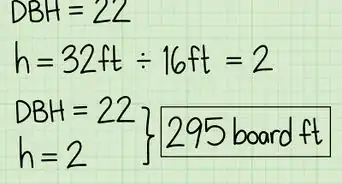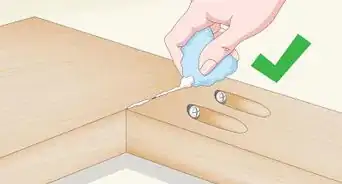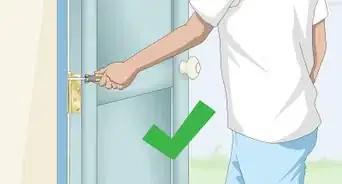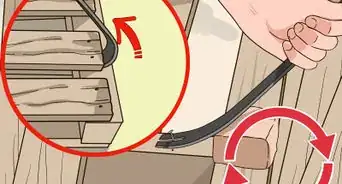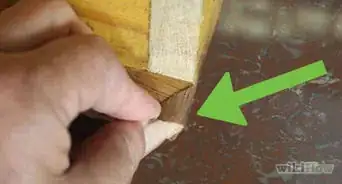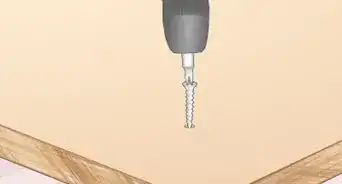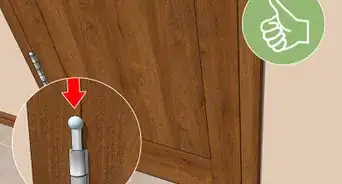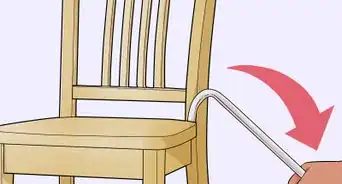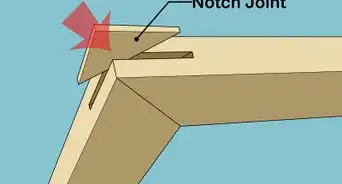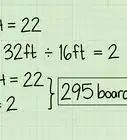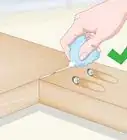This article was co-authored by Lauren Kurtz and by wikiHow staff writer, Janice Tieperman. Lauren Kurtz is a Naturalist and Horticultural Specialist. Lauren has worked for Aurora, Colorado managing the Water-Wise Garden at Aurora Municipal Center for the Water Conservation Department. She earned a BA in Environmental and Sustainability Studies from Western Michigan University in 2014.
There are 13 references cited in this article, which can be found at the bottom of the page.
This article has been viewed 95,978 times.
Chopping down a tree is definitely a big undertaking, but it’s not as hard as you might think. As long as you have the right equipment and take some precautions, you can safely fell a tree on your own. Keep reading for a step-by-step guide through this straightforward process.
Steps
Warnings
- Double-check for any obstacles before you start chopping down any trees. Also, make sure the tree is a safe distance away from your home and any other nearby buildings.[22]⧼thumbs_response⧽
- If you aren’t experienced with chainsaws, consider renting or buying a reduced kickback saw chain. It’s slower than other types of chainsaws, but it’s a lot safer to use.[23]⧼thumbs_response⧽
- Never use a chainsaw without the proper safety equipment, like sturdy boots, safety glasses, work gloves, long pants, and earplugs.[24]⧼thumbs_response⧽
- Never look away from the chainsaw bar while chopping down a tree.[25]⧼thumbs_response⧽
References
- ↑ https://www.youtube.com/watch?v=Os2vrOT8F1Q&t=0m37s
- ↑ https://www.bobvila.com/articles/felling-a-tree/
- ↑ https://stormwise.uconn.edu/thinking-of-cutting-down-a-small-tree-safety-first/#
- ↑ https://www.bobvila.com/articles/felling-a-tree/
- ↑ https://www.youtube.com/watch?v=Os2vrOT8F1Q&t=0m9s
- ↑ https://www.youtube.com/watch?v=Os2vrOT8F1Q&t=0m51s
- ↑ https://www.bobvila.com/articles/felling-a-tree/
- ↑ https://www.youtube.com/watch?v=Os2vrOT8F1Q&t=0m55s
- ↑ https://www.bobvila.com/articles/felling-a-tree/
- ↑ https://stormwise.uconn.edu/thinking-of-cutting-down-a-small-tree-safety-first/#
- ↑ https://www.bobvila.com/articles/felling-a-tree/
- ↑ https://stormwise.uconn.edu/thinking-of-cutting-down-a-small-tree-safety-first/#
- ↑ https://www.youtube.com/watch?v=bIBeL-3RB1U&t=2m45s
- ↑ https://www.bobvila.com/articles/felling-a-tree/
- ↑ https://www.youtube.com/watch?v=Os2vrOT8F1Q&t=1m14s
- ↑ https://www.bobvila.com/articles/felling-a-tree/
- ↑ https://www.bobvila.com/articles/felling-a-tree/
- ↑ https://www.youtube.com/watch?v=Os2vrOT8F1Q&t=105s
- ↑ https://www.bobvila.com/articles/felling-a-tree/
- ↑ https://www.youtube.com/watch?v=Os2vrOT8F1Q&t=1m54s
- ↑ https://www.youtube.com/watch?v=Os2vrOT8F1Q&t=2m31s
- ↑ https://www.thisoldhouse.com/landscaping/21017220/how-to-cut-down-a-tree-safely
- ↑ https://www.popularmechanics.com/home/tools/reviews/a11294/7-simple-chainsaw-safety-rules-17209863/
- ↑ https://www.popularmechanics.com/home/tools/reviews/a11294/7-simple-chainsaw-safety-rules-17209863/
- ↑ https://www.popularmechanics.com/home/tools/reviews/a11294/7-simple-chainsaw-safety-rules-17209863/
About This Article
Before chopping down a tree, check the area around you to make sure there are no hazards. For example, look for things that the tree could fall on, such as buildings, vehicles, or power lines. Try to choose a day when there won’t be a lot of wind or rain, since this could affect how the tree falls. Wear a long-sleeved shirt, long pants, work gloves, sturdy work boots, a hard hat, and goggles to protect yourself while you work. Choose a chainsaw that is appropriate for the size of the tree you’re cutting down. For instance, use a 16 to 18 in (41 to 46 cm) chainsaw for small to medium trees, and a 20 to 24 in (51 to 61 cm) for larger trees. Use pruning shears to cut away any undergrowth at the base of the tree and move the debris out of the way. Stand on the opposite side of the tree from the direction it will fall. You can usually determine the fall direction by observing the natural lean of the tree—it should fall in the direction it’s leaning. Turn yourself 45° to the left and make sure there’s a clear path in that direction in case the tree starts to fall toward you. Make sure you also have a clear path 90° to your right in case you need an alternate escape route. Then, go around to the side of the tree where you’d like it to fall and cut a notch about 1/3 of the way into the trunk with your saw. Make the cut downward at a 70° angle. Then, make a horizontal cut directly under the first cut to remove a triangular wedge of wood. Go to the other side of the tree and line up your saw with the bottom edge of the notch you made, then cut across the trunk horizontally to the notch on the other side in a smooth motion. When there’s about 10% of the trunk left between the notch and the cut on the other side, the tree should start to fall. Turn on the brake on your chainsaw and pull it out of the tree, then quickly move a safe distance away using your planned escape route. Move backward so you can keep watching the tree to make sure it isn’t falling in your direction.


